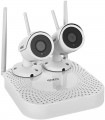Matrix size
The physical size of the sensor in the pointed cameras is diagonally, in inches (fractions of an inch).
The larger the sensor, the less prone it is to noise, the better image quality it can provide, and the better it is suited to low light conditions. This is due to the fact that each individual pixel gets more light, because. on a large matrix and individual dots are larger. On the other hand, large matrices are more expensive.
Number of megapixels
Sensor resolution of pointed cameras in megapixels (millions of pixels).
Higher resolution allows you to get a more detailed "picture". However, increasing the number of megapixels without increasing the sensor size can result in poor overall image quality and noise, especially in low light. Therefore, in itself, the high resolution of the matrix does not guarantee high quality shooting.
Horizontal viewing angle
The viewing angle of the directional cameras supplied as standard is horizontal.
Wide viewing angles allow you to cover a large area; this is especially important given that directional cameras are often made stationary. On the other hand, all other things being equal, a larger viewing angle will mean a lower degree of magnification - objects will look smaller, detail will be worse. Therefore, when choosing according to this parameter, you should proceed from what is more important - a wide field of view or “range”.
Recording resolution
The maximum frame resolution in which the complete recorder can record video if all video channels are involved in operation. In fact, we are talking about the highest resolution in maximum load mode; if some channels are idle, some models allow higher resolutions. However, it is customary to indicate this parameter in the specifications - it most accurately characterizes the capabilities of the device.
As for the resolution itself, the higher it is, the more detailed the image is; on the other hand, such video requires significant processing power and capacious storage drives, which affects the final cost of the equipment.
Popular maximum frame resolutions in which modern recorders record:
HD (720),
Full HD (1080),
Quad HD,
Ultra HD (4K).
Video compression format
The format in which the kit recorder records digital video.
This setting determines the codecs required to view content on external devices. When viewing on a computer with codecs, there are usually no problems: their set in modern operating systems is quite extensive, and the missing modules, usually, are easily found and installed via the Internet. But if you plan to view video materials through a media centre, a TV with direct playback via USB, etc. — It is worth making sure that this device supports the appropriate compression formats.
Technical details on different standards can be found in special sources.

